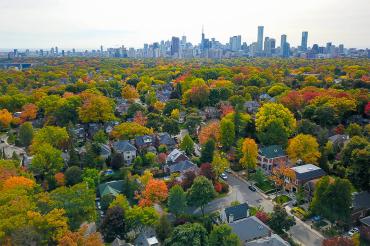Toronto's low-income and racialized communities have fewer trees: U of T researchers

Published: October 26, 2020
An afternoon walk along Toronto’s Harbourfront neighbourhood was the genesis of Jacqueline Scott’s doctoral thesis at the University of Toronto.
“I saw a sign for a camping trip and out of sheer boredom decided to give it a go,” she says, adding that the weekend in the woods changed her life. “Something clicked in my soul.”
Scott started spending every spare minute outdoors – camping, hiking, biking, skiing and snowshoeing – as a member of multiple outdoor clubs. Yet, as her skills grew, so did the questions.
“Ninety-nine per cent of the time I’m the only Black person in the group. Why? Why are there white people in the woods and not Black? What’s going on in that space?”
Scott’s questions led her to the U of T’s Ontario Institute for Studies in Education, where she’s been pursuing her PhD in social justice education since 2016. The subject of her thesis: How to make environmentalism more welcoming for Black people.
When it comes to outdoor recreation, the conservation industry, even the climate change movement, “there are barriers based in the legacies of history,” Scott says. “We don’t see ourselves advertised. They don’t have Black people on staff. It sends a clear message that if you’re Black, this isn’t your space.”
Scott recently shared her research in Urban Forests in a Changing Climate, the latest in a series of reports from the Greenbelt Foundation that explore the impact of climate change on people’s daily lives. The report discusses the role trees play in helping communities in the Greater Golden Horseshoe region of southern Ontario mitigate and adapt to climate change, and how race shapes where trees are planted, who benefits from them and who takes part in their planting.
“Research shows that poor and racialized communities have less access to green space in the city,” Scott writes in the report. “The absence of trees is another layer of inequality in lives shaped by oppression.”
Scott points to her own neighbourhood, Toronto’s Regent Park. While undergoing a revitalization, the area is historically home to one of Canada’s largest and oldest social housing developments. In 2016, 70 per cent of residents identified as visible minorities. There are also noticeably fewer trees in Regent Park, Scott observes, compared to nearby Rosedale, where just 18 per cent are racialized.
“The whiter the neighbourhood, the more trees and birds,” Scott says, adding her research shows that tree planting is more likely to occur in rich white areas than poor Black ones. What’s more, she says, tree planting groups often include a preponderance of white volunteers and staff.
“Within the field of urban forestry, there’s widespread recognition that in most North American cities, trees are unevenly distributed relative to the income and racial characteristics of neighbourhoods,” agrees Tenley Conway, a professor of environmental geography at U of T Mississauga who co-authored the report with Scott.
“It’s concerning when recognizing that trees contribute to climate change mitigation and to our physical and emotional well-being.”
In the Greater Toronto Area, the urban forest includes an estimated 34.2 million trees representing more than 100 species. About one-quarter of the region is under the cover of trees, which, Conway writes, play an important role in reducing the amount of carbon dioxide in the atmosphere, regulating temperature, decreasing flooding and protecting local biodiversity.
Conway calls on local municipalities to include urban forests in their long-term management plans. Homeowners and rural landowners can also help by protecting existing trees, planting new ones and watering young trees during droughts.
She says it’s important to plant a diversity of tree species in a diversity of spaces.
In the City of Mississauga, for example, 43 per cent of the current tree canopy is located on residential property, but there are still opportunities to increase its size. The “city-wide canopy cover could increase by 12 to 19 per cent if all available spaces on residential land were planted with trees.”
As for the relationship between trees and race, both Scott and Conway say the time is right to raise awareness of the issue and to advocate for change.
“The global pandemic has highlighted the important mental health benefits of getting outside and accessing the urban forest and being able to do so close to home,” says Conway.
Scott agrees, saying: “Prior to COVID, most of the Black people I saw in Toronto’s ravines were people I brought there. COVID has changed that. It’s opened the door to a new opportunity to invite people of colour to engage in the outdoors.”
Whether they continue to do so or not will depend on the ability of our environmental leaders and organizations to acknowledge that race is an issue, Scott says, adding they must also build strong relationships with the Black community and hire more Black staff.
“If a diverse photo op is your only step, nothing has changed.”



